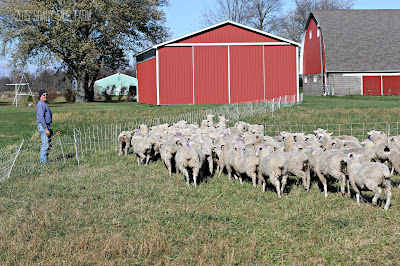Earlier this year we separated the lambs from their mothers, and moved them to the other side of the road. They've grazed that hayfield twice over since then. And now that the grass isn't regrowing much due to short days and cold nights, it's time to give that hayfield a rest. And it is also time to move the lambs on to their next purpose. The ewe lambs that are keepers will be put in with the ewe flock for possible fall breeding. The wethers (castrated ram lambs) will become lamb chops, and other related food products.
The first item of business was to block off where the horses are. The last time we moved lambs, they took a detour into the horse pasture. The horses thought the lambs were a real-life version of a "whack-a-mole" game. No lambs were injured in the excitement, but it's a wonder. We didn't need that happening again.
The second item of business was the planning meeting. We sometime skip this step, but the fact that we held one shows how serious this lamb drive was. It really, really helps if we are all on the same page and have a passing knowledge of the overall game plan. Things change mid-stream, sometimes, but it does help to go over what we hope will happen.
Not all of us listened well.
We did have some fence set up to guide the lambs in the general direction we wanted them to go. Here's The Farmer, dramatically releasing the lambs from their pen.
Here's the non-stampede, as the sheep cautiously investigated the opening and tried to decide whether or not to go through it.
Finally, one felt brave enough, and they all moved as a group in the direction we wanted them to go.
Great. So far, so good. We had people stationed on both sides, hoping that a person positioned here and there would act like a fence and funnel the sheep to the other side of the road.
It didn't work. Here's a picture of the lambs as they made a break for it. One or two of us (not me) were able to run fast enough to turn them around and head them back towards the narrow driveway (lower right in the picture below) they needed to cross to get to their destination.
Finally they headed where we wanted them to go, after their short detour.
Never a dull moment at Shady Side Farm...









Very interesting article.
ReplyDeleteI have learned a lot form this blog.
Thanks for sharing with us.
You have so much fun! Wish we were nearer (I'd chase sheep if you lent me a horse:)
ReplyDelete